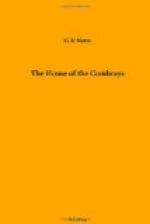“I respectfully remain,
“Your Majesty’s very humble and obedient servant,
“De Combray.”
It was, as we see, a general confession. What must have been the Marquise’s grief and rage on learning that she had been deceived? At what moment did Licquet cease to play a double part with her? With what invectives must she not have overwhelmed him when he ceased? How did Mme. de Combray learn that her noblest illusions had been worked upon to make her give up her daughter and betray all her friends? These are things Licquet never explained, either because he was not proud of the dubious methods he employed, or, more probably, because he did not care what his victims thought of them. Besides, his mind was occupied with other things. Mme. de Combray had hinted to Delaitre that d’Ache usually stayed in the neighbourhood of Bayeux, without stating more precisely where, as she was certain he would easily be found beside the newly landed King. Licquet, therefore, went in search of him, and his men scoured the neighbourhood. Placene, for his part, annoyed at finding that Allain did not keep his word and made no attempt to deliver his imprisoned comrades, gave some hints. In order to communicate with Allain and d’Ache, one was, according to him, obliged to apply to an innkeeper at Saint-Exupere. This man was in correspondence with a fellow named Richard, who acted as courier to the two outlaws. “Between Bayeux and Saint-Lo is the coal mine of Litre, and the vast forest of Serisy is almost contiguous to it. This mine employed five or six hundred workmen, and as Richard was employed there one was inclined to think that the subterranean passages might serve as a refuge to Allain and d’Ache, whether they were there in the capacity of miners, or were hidden in some hut or disused ditch.”
The information was too vague to be utilised, and Licquet thought it wiser to direct his batteries on another point. He had under his thumb one victim whom as yet he had not tortured, and from whom he hoped much: this was Mme. Acquet. “She is,” he wrote, “a second edition of her mother for hypocrisy, but surpasses her in maliciousness and ill-nature.... Her children seem to interest her but little; she never mentions them to any one, and her heart is closed to all natural sentiments.”
But I believe that it was to excuse himself in his chief’s eyes that Licquet painted such a black picture of the prisoner. His own heart was closed to all compassion, and we find in this man the inexorable impassibility of a Laffemas or a Fouquier Tinville, with a refined irony in addition which only added to the cruelty. The moral torture to which he subjected Mme. Acquet is the product of an inquisitor’s mind. “At present,” he remarked, “as the subject is somewhat exhausted, I shall turn my attention to setting our prisoners against one another. The little encounter may give us some useful facts.”




